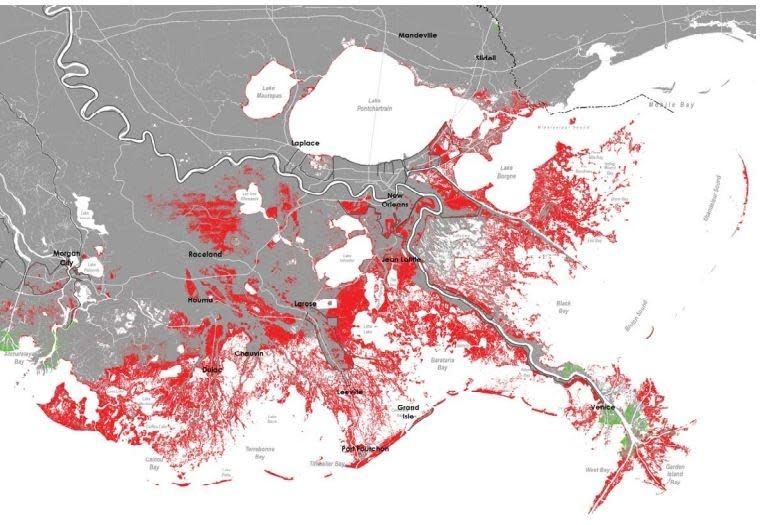Major project to help save Louisiana's eroding coast wins key approval as debate continues

A $2.3 billion diversion of the Mississippi River designed to help preserve much of southeast Louisiana's eroding coast crossed a key hurdle this week.
The Army Corps of Engineers granted permits that allow the Mid-Barataria Sediment Diversion to proceed.
The project aims to restore and sustain eroding wetlands in and around Barataria Bay, an area that stretches roughly from southeastern Lafourche Parish to southwestern Plaquemines. The wetlands buffer New Orleans and other communities from hurricanes and storm flooding.
The permits' approval, announced Monday, drew praise from environmentalists and opposition from fishermen who have long criticized the river diversion because it would damage oyster beds and shrimp habitats.
Corps officials said their evaluation shows the project would cause the least environmental damage among seven options considered, including one that would take no action to preserve the wetlands.
“We take great care to neither endorse nor oppose any project when administering our regulatory authorities,” Col. Cullen Jones, the corps' New Orleans District commander, said in a news release. “Our responsibility is to use the science, engineering, technology and data available to make the best-informed decision.”
Related:Louisianans have tried to tame the Mississippi River for decades. Now they may set it free
More:Groundbreaking marks first federal dollars spent on Morganza hurricane-protection system
The Louisiana Coastal Protection and Restoration Authority plans to lead the project as part of its $50 billion long-range plan to protect a coast that has lost about 2,000 square miles of wetlands since 1932 to erosion, sinking and hurricanes. Money for the diversion, which would channel part of the river's flow from Plaquemines Parish into Barataria Bay, would come from Louisiana's settlement with BP for damage caused by the 2010 Gulf of Mexico oil spill.
The state's plans estimate the diversion will build as much as 17,300 acres, or 27 square miles, of wetlands by 2070. Louisiana officials said they hope to start construction sometime next year.
“Today is a monumental day for the state of Louisiana,” Gov. John Bel Edwards said in a statement. “The Mid-Barataria Sediment Diversion is a first-of-its-kind environmental infrastructure project that will exist in our own backyard to serve areas experiencing some of the highest rates of land loss in the world.
"The project also represents a major step forward to restoring damages suffered by our coastal estuaries as a result of the Deepwater Horizon oil spill. Communities we feared could be removed from the map in 50 years will instead see thousands of acres of wetlands in the future that will provide them with natural and sustainable protection."

The permits' approval drew praise from Restore the Mississippi River Delta, a coalition of national and local conservation organizations comprised of Environmental Defense Fund, National Audubon Society, the National Wildlife Federation, the Coalition to Restore Coastal Louisiana and Pontchartrain Conservancy
“What a great Christmas and New Year’s gift,” said Robert Gorman of Thibodaux, one of the founders of the Coalition to Restore Coastal Louisiana. “The Mid-Barataria Sediment Diversion project gives hope for the future of the Barataria Basin. We raised our family along Bayou Lafourche, and I helped start CRCL to champion projects like this one to keep the basin alive and healthy.”
Commercial fishing groups have opposed the project, saying it will destroy their livelihoods by dumping fresh water into salt and brackish waters that support seafood.

The state plan includes about $300 million aimed at offseting the diversion's impact on fisheries, though opponents remain unconvinced.
“We know $300 million isn’t going to be enough to take care of the industry,” Louisiana Shrimp Association President Acy Cooper told New Orleans Public Radio station WWNO on Monday, adding that lawsuits will soon be filed challenging the project. "They know what’s going to happen, and for them to move forward with this is just ludicrous. It’s a damn shame.”
This article originally appeared on Daily Comet: Major project to help save Louisiana's eroding coast wins key approval

